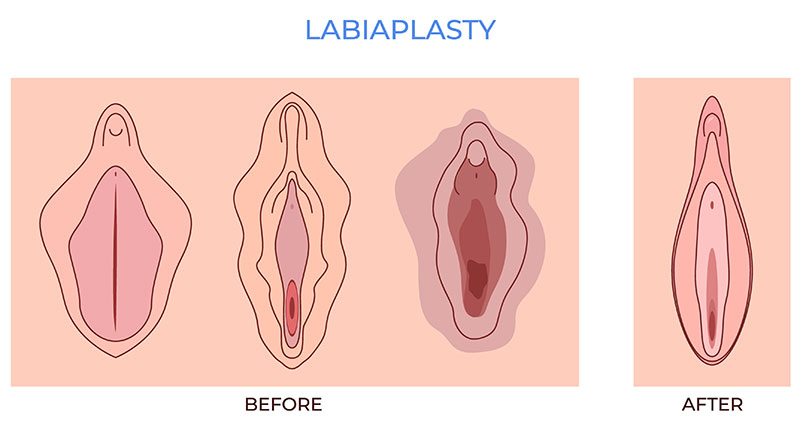Labiaplasty is nothing more than a simple solution to a minor problem. Dr. Preminger wants the approach to be delicate and factual, focusing on self-esteem, sexual health in marriage, comfort in athletics, etc.
Labiaplasty is a sensitive procedure that raises many questions. Dr. Aviva Preminger has answers.
Labiaplasty in NYC
Labiaplasty is often confused with vaginal rejuvenation, but the two procedures address different concerns. Labiaplasty is the surgical repair or restoration of the labia majora or labia minora—the outer and inner lips of skin surrounding the vulva. This procedure is performed not only for aesthetic improvement and day-to-day comfort but also to correct asymmetry and address hyperpigmentation along the edges of the labia. Unlike vaginal rejuvenation, which focuses on tightening internal vaginal tissues, labiaplasty enhances the appearance and comfort of the external folds. This procedure can be done under local anesthesia, making it a more convenient option for many patients.
“A labiaplasty procedure is intended to excise or remove extra tissue and help address extra pigmentation,” says Dr. Preminger. “Sometimes for patients, this is simply a cosmetic concern that makes them feel self-conscious. And then sometimes for other patients, it’s actually a functional concern — doing sports such as bicycling, yoga, ballet and particularly when they’re wearing a lot of tight clothing, the area can actually become irritated.”
“As a female plastic surgeon, in particular, I really think it’s important that patients have the opportunity to have this addressed, particularly if it’s bothersome to them from either a cosmetic or a functional perspective. The patients are generally very satisfied with the results and happy they finally decided to do it.”
Common reasons to have labiaplasty include:
- To correct a natural irregularity such as an uncomfortably large labia
- To improve the size or shape of vaginal lips that have become stretched over time or with childbirth
- To correct asymmetry
- To address hyperpigmentation of labia edges
- To enhance intimacy
- To resolve pain from an enlarged labia that has become irritated by tight clothing, sex, or physical activity
- To be happier with your body, and feel more comfortable with a partner

Labiaplasty is performed right in Dr. Preminger’s office under local anesthesia or conscious sedation, which means you’ll be lightly sleeping on a short-acting drug while we monitor your vitals and be awakened when the procedure is finished. As you sleep, the surgeon will measure and mark excess labial skin for removal, trim it with a scalpel or surgical scissors, and use absorbable sutures to close the incisions. Your surgeon may choose several different techniques, depending on your unique anatomy, which will be discussed during the consultation.
Typically, the whole procedure is finished in 1-2 hours. You will need to spend a few hours for recovery at Dr. Preminger’s facility under the supervision of a nurse before returning home.
Recovery
Some discomfort at the surgical site can be expected for the first few days. Patients are sent home with prescriptions for pain medication and antibiotics to ensure greater comfort during the healing process. The first few weeks are the toughest, while swelling, discoloration, and pain are highest. Full healing takes place at approximately six weeks when swelling subsides, but most people are back to work after 2-4 days and resume light exercise as early as four weeks. For the first week, you should not lift more than five pounds. Strenuous activity and sexual intercourse should be avoided for 6-8 weeks.
You’ll want to look out for signs of complications, such as: a fever over 100.4 degrees, increased redness along the incision, increased bruising and swelling, vomiting, dizziness, headache, yellow or green discharge, foul odor, and bleeding that does not stop with gentle pressure.
Here are a few other tips for labiaplasty recovery:
- Wear comfortable gowns and loose clothing for the first few days.
- You may shower 48 hours after surgery. Avoid tub soaking until the sutures dissolve.
- Keep your incisions clean and dry. You will be instructed on how to look for signs of infection.
- Feminine napkins should be worn to absorb any drainage, which is normal.
- Take pain medication as prescribed on schedule. Avoid drinking alcohol.
- Drink plenty of water and add more fresh fruit to your diet.
Video Transcription:
[B. Aviva Preminger, MD Board Certified Plastic Surgeon] A labiaplasty is a procedure that’s designed to address the extra tissue of what we call the labia minora and patients who have this sometimes complain of too much tissue in this area. Sometimes they complain of an asymmetry or a size difference on the right and left sides of their labia and sometimes they complain of too much pigmentation in this area and so we can actually address any of these concerns with a labiaplasty procedure which is actually intended to excise or just remove the extra tissue and help address extra pigmentation or basically just too much tissue and sometimes for patients this is simply a cosmetic concern that makes them feel self-conscious and then sometimes for other patients, it’s actually a functional concern. So when you have an active patient who’s doing sports such as bicycling, yoga, ballet, and particularly when they’re wearing a lot of tight clothing, they can not only feel self-conscious, but the area can actually become irritated so a labiaplasty is actually a very powerful tool to address all of these concerns for patients.

